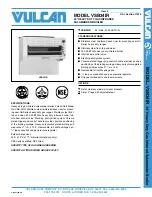
SERIES 8800 & 8900 INSTALLATION AND OPERATING INSTRUCTIONS
Page 23
Required Gas Pressure
Provide gas supply pressure at inlet to boiler gas train
as follows:
LP
Nat
Minimum (in W.C.)
11
6
Maximum (in W.C.)
14
14
Measure pressure when the boiler is firing at full rate.
Low gas pressure could indicate undersized gas line or
insufficient gas supply.
"Static and operating gas pressure required at the gas
valve inlet is between 6" W.C. and 14" W.C. for natural
gas and 11" W.C. and 14" W.C. for propane. If the gas
pressure is above this limit, a lock-up style regulator
suitable for dead end service such as an Equimeter
or Fisher must be installed to prevent increase (creep)
of gas pressure when the units are not operating.
This pressure regulator (supplied by others) may be
installed at the service entrance to each unit or a
"master" regulator sized to handle multiple units may
be utilized. Consult local gas utility or regulator
manufacturer for recommendations to meet specific job
site requirements."
Table 10 - Pilot & Manifold Settings
Instructions De Mise En Marche
1.
ARRÊTEZ! Lisez les instructions de sécurité sur la
portion supérieure de cette étiquette.
2.
Réglez le thermostat à la température la plus basse.
3.
Coupez l’alimentation électrique de l’appareil.
4.
Cet appareil est muni d’un dispositif d’allumage qui
allume automatiquement la veilleuse. Ne tentez pas
d’allumer la veilleuse manuellement.
5.
Fermer la vanne manuelle d’arrêt d’alimintation de gaz.
6.
Attendre cinq (5) minutes pour laisser échapper tout
le gaz. Reniflez tout autour de l’appareil, y compris
près du plancher, pour déceler une odeur de gaz.
Si vous sentez une odeur de gaz, ARRÊTEZ!
Passez à l’étape B des instructions de sécurité sur
la portion supérieure de cette étiquette. S’il n’y a pas
d’odeur de gaz, passez à l’étape suivante.
7.
Ouver la vanne manuelle d’arrêt d’alimintation de gaz.
8.
Mettez l’appareil sous tension.
9.
Réglez le thermostat à la température désirée.
10. Si l’appareil ne se met pas en marche, suivez les
instructions intitulées «Comment couper l’admission
de gaz de l’appareil» et appelez un technicien
qualifié ou le fournisseur de gaz.
inches W.C.
mm W.C.
Natural
3.5 (
±
.2)
89 (
±
5)
Propane
10 (
±
.2)
254 (
±
5)
To Turn Off Gas To Appliance
1.
Set the operating control or thermostat to its lowest
setting.
2.
Turn off all electric power to the appliance if service
is to be performed.
3.
Close the manual main and pilot gas shut-off valves.
COUPER L’ADMISSION DE GAZ DE L’APAREIL
1.
Réglez le thermostat à la température la plus basse.
2.
Coupez l’alimentation électrique de l’appareil s’il faut
procéder à l’entretien.
3.
Fermer la vanne manuelle d’arrêt d’alimintation de gaz.
CHECKING & ADJUSTMENTS
1.
With the burners in operation, close the manual
shutoff valve in the gas supply line. As soon as the
main burner flames go out, open the manual shutoff
valve. A normal ignition sequence should take place.
If the burners fail to light, the system will make one
more ignition attempt. If the burners have not lit after
the last ignition try, the gas valve will close and the
system will go into lock out on CSD-1 units or
continuous retry. DO NOT attempt to reset the
system until the ignition system has been inspected
and the problem resolved. The pilot and manifold
pressures should match those listed in Table 10.
2.
With the burners in operation, interrupt the power
to the control circuit by lowering the operating
control or thermostat. The main burners should go
out. Reset the operating control or thermostat, a
normal ignition sequence should follow.
3.
To test the ignition safety shutoff device, close the
manual shutoff valve in the gas supply line. Within
5 seconds of main burner flame extinction, the main
gas valve solenoid should close with an audible
noise.
4.
A sparking noise should be heard while the ignition
module tries to relight the pilot. After 15 seconds the
module should lockout and the trial for ignition end.
After 5 minutes a second trial for ignition should
occur. Open the manual shutoff valve in the gas
supply line and reset the ignition control system. A
normal ignition sequence should take place.
















































